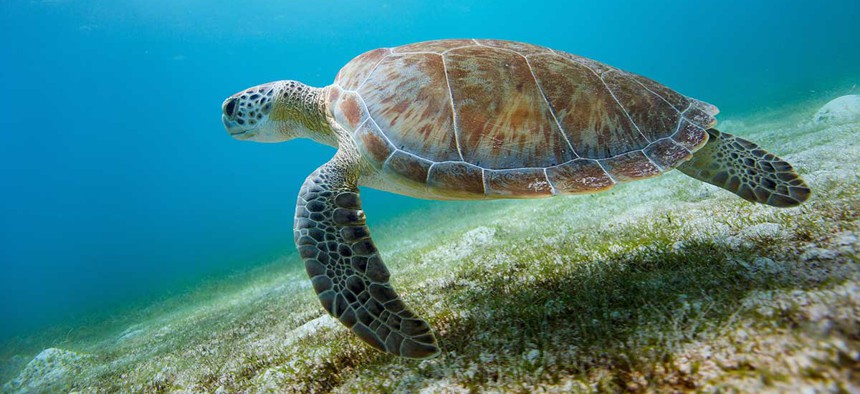
BlueOrange Studio/Shutterstock.com
Sea Turtles Get the Spotlight in U.S.-Cuba Thaw
The State Department says the two nations are working together to protect the ecosystem along their marine border.
Diplomats are learning, as magazine editors discovered years ago, that posting cute animal photos on the internet is a great way to promote a controversial foreign policy decision.
The State Department is testing the proposition by highlighting one effect of President Obama’s year-old decision to restore diplomatic ties with Cuba.
A post on State’s DipNote blog features a photo of the endangered Hawksbill sea turtle atop a description of joint environmental work between the once-estranged nations: “One of the first fruits of this new relationship is a plan to increase cooperation in marine protection.”
“With only ninety miles of sea dividing the United States and Cuba, collaboration on marine matters is especially important,” writes Judith Garber, a top State environmental official. Her post describes the plan hatched this fall to collaborate on research, education and resource management in “marine protected areas.”
The two nations are establishing “sister” protected regions, which initially are the Florida Keys and Flower Garden Banks National Marine Sanctuaries on the U.S side and Cuba’s Guanahacabibes National Park and the Banco de San Antonio, State said.
It’s part of broader efforts now under way to boost environmental collaboration with Cuba on topics including climate change and boosting resilience to hurricanes and other disasters.
Garber notes that marine conservation and pollution are topics that transcend national boundaries — and that collaboration on issues has broader repercussions. “Such engagement can cross political divides and is often at the vanguard of broader agreements,” writes Garber, who is acting head of State’s Bureau of Oceans and International Environmental and Scientific Affairs
Back to those very endangered and very cute turtles. According to the National Oceanic and Atmospheric Administration, the Caribbean is home to one of the world’s largest populations of the Hawksbill, which get their name from the beak-like shape of their mouths.
Protecting them is an important way to safeguard other features of the shared U.S. Cuba ecosystem too, and that’s due to their eating habits, according to State.
“The hawksbill’s primary food source is the marine sponge, which competes for space with coral colonies,” Garber writes. “A single hawksbill can devour an estimated 1,200 lbs of sponges each year, so it’s not a stretch to say that turtles hatched in Cuba go on to protect coral reefs in Florida and throughout the Gulf of Mexico.”
(Image via BlueOrange Studio/Shutterstock.com)
NEXT STORY: Reshaping Government Recruitment







